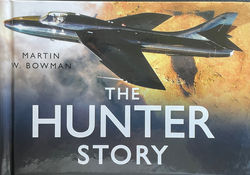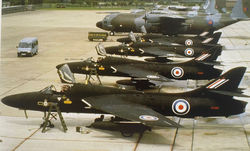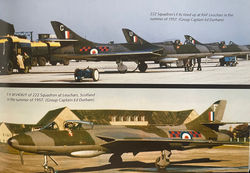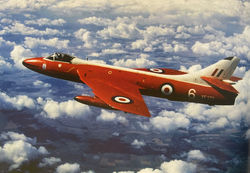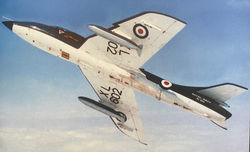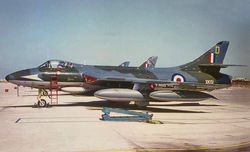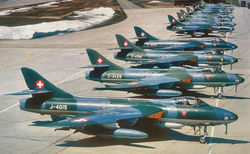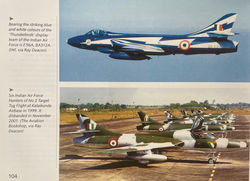HAWKER
HUNTER STORY RAF COMMONWEALTH INDIA SWITZERLAND SWEDEN INDIA CHILE IRAQ
HARDBOUND BOOK in ENGLISH by
MARTIN W. BOWMAN
TRIALS AND TRIBULATIONS (P.1067
PROTOTYPE, ROLLS-ROYCE AVON POWERED HUNTER Mk.1, ROLLS-ROYCE SAPPHIRE POWERED
HUNTER Mk.2, Mk.3 RECORD SETTING PROTOTYPE, HUNTER Mk.4, HUNTER Mk.5, HUNTER
F.Mk.6, TWO SEATER T.Mk.7, ROYAL NAVY FLEET AIR ARM T.Mk.8, GROUND ATTACK
FGA.9, FR.Mk.10 RECONNAISSANCE, RN FAA Mk.11)
EXPORT VARIANTS (DENMARK ROYAL
DANISH AIR FORCE, SWEDEN ROYAL SWEDISH AIR FORCE SVENSKA FLYGVAPNET, INDIA,
SWITZERLAND FLIEGERKORPS, DUTCH ROYAL NETHERLANDS AIR FORCE, BELGIUM FAB, ABE
DHABI, CHILE, KENYA, KUWAIT, OMAN, QATAR, RHODESIA, ZIMBABWE, SAUDI ARABIA,
SINGAPORE)
CONSTRUCTION
AIRFRAME (NOSE, LANDING LIGHT,
COCKPIT, AIR INTAKE, REFUELING ACCESS, HYDRAULICS ACCESS PANEL, FIN / RUDDER,
HORIZONTAL STABILIZER, TRIM TABS, TAILPIPE, AIR BRAKE, ANTI-COLLISION LIGHT,
EMERGENCY ARRESTER HOOK)
WINGS (WING FENCES, VORTEX
GENERATORS, LEADING EDGE, FLAPS, WING TIP LIGHTS)
UNDERCARRIAGE LANDING GEAR (NOSE
WHEEL, GEAR DOORS, STRUTS, WHEEL WELLS, PORT / STARBOARD MAIN LANDING GEAR,
BRAKE LINES)
COCKPIT (INSTRUMENT PANEL,
CANOPY, CONTROL STICK, RUDDER PEDALS, EJECTION SEAT – MARTIN BAKER Mk.2H)
WEAPONS & STORES (PYLONS,
30mm ADEN GUN, ROCKET PODS, DROP TANKS, BOMBS, AAM AIR-TO-AIR MISSILES)
ADDITIONAL INFORMATION REGARDING
THE HAWKER HUNTER
ROYAL AIR FORCE FRONT-LINE
HUNTER SQUADRONS
F.2 F.5 T.7 FGA.9 RAF No.1 SQN
TANGMERE / STRADISHALL
T.7 RAF No.1 SQN
FR.10 T.7 RAF GERMANY No.2 SQN
WILDENRATH
F.4 RAF GERMANY No.3 SQN
GUTERSLOH
F.4 F.6 FR.10 T.7 RAF GERMANY
No.4 SQN JEVER GUTERSLOH (WEST RAYNHAM IN UK)
FGA.9 T.7 RAF No.8 SQN YEMEN /
ADEN STRIKE WING / BAHRAIN
F.4 F.6 RAF GERMANY RAFG No.14
SQN
F.6 F.8 T.7 RAF No. 19 SQN
CHURCH FENTON / LECONFIELD
F.4 FGA.9 T.7 RAF No. 20 SQN
OLDENBURG RAFG / TENGAH SINGAPORE
F.4 F.6 RAF GERMANY RAFG No.26
SQN OLDENBURG GUTERSLOH
FGA.9 T.7 RAF HONG KONG No.28
SQN KAI TAK
F.5 RAF No.34 SQN NICOSIA CYPRUS
MUSKETEER SUEZ OPERATIONS 1956 / TANGMERE
F.5 RAF No.41 SQN BIGGIN HILL
F.1 F.4 T.7 FGA.9 RAF No.43 SQN
LEUCHARS KHORMAKSAR ADEN STRIKE WING
T.7 FGA.9 RAF No.45 SQN
WITTERING
F.1 F.4 F.6 T.7 FGA.9 RAF No.54
SQN RAF ODIHAM STRADISHALL WATERBEACH WEST RAYNHAM
F.5 F.6 T.7 RAF No.56 SQN RAF
CYPRUS NICOSIA / WATERBEACH /WATTISHAM
FGA.9 T.7 RAF No.58 SQN
WITTERING
F.6 RAF No.63 SQN WATERBEACH
F.6 T.7 No.65 RAF DUXFORD
F.4 F.6 T.7 RAF No.66 RAF
ACKLINGTON
F.4 RAF No.67 SQN
F.4 RAF No.71 SQN
F.4 F.6 No.74 SQN RAF COLTISHALL
F.4 F.6 No.92 SQN RAF LECONFELD
T.7 RAF BLUE DIAMONDS AEROBATIC
DISPLAY TEAM
F.4 F.6 RAF No.93 SQN
F.4 No.98 SQN RAF GERMANY JEVER
F.4 No.111 SQN, No.112, No.118,
No.130
F.6 No.208 SQN TANGMERE ADEN
RAF No.222 SQUADRON, No.234 SQN,
No.245 SQN
F.6 RAF No.247 RAF ODIHAM
RAF No.257 SQN
F.6 No.263 SQN RAF STADISHALL
OTHER RAF HUNTER UNITS &
GOVT ESTABLISHMENTS: No.12 SQN, No.15 SQN, No.16 SQN, No.216 SQN, FGA.9 No.229
OCU, No.233 OCU, No.237 OCU, No.1 TWU, No.2 TWU, HARRIER CONVERSION UNIT,
No.1417 FLIGHT, No.4 FTS, RAF STATION FLIGHTS, FIGHTER WEAPONS SCHOOL, T.7A
CENTRAL FLYING SCHOOL RAF LITTLE ROSSINGTON, CENTRAL FIGHTER ESTABLISHMENT, F.6
A&AEE, T.7 ETPS, F.6 COMBAT FIGHTER SCHOOL, HUNTER P.1109B RAE / RRE
ROYAL NAVY FLEET AIR ARM HUNTER
SQUADRONS
700 & 736 NAS
738 NAS
759 NAS
GA.11 No.764 SQN LOSSIEMOUTH
No.800 NAS
No.899 NAS
FRADU
FAA STATION FLIGHTS
AIR DIRECTION UNITS
FAA STATION FLIGHTS OVERSEAS
T.8 FLAG OFFICER FLYING TRAINING
FAA YEOVILTON
RAF COLOR SCHEMES
NATIONAL MARKINGS
AIRCRAFT IDENTITY SERIAL NUMBERS
UNIT MARKINGS
TRIALS AND TRIBULATIONS (P.1067
PROTOTYPE, ROLLS-ROYCE AVON POWERED HUNTER Mk.1, ROLLS-ROYCE SAPPHIRE POWERED
HUNTER Mk.2, Mk.3 RECORD SETTING PROTOTYPE, HUNTER Mk.4, HUNTER Mk.5, HUNTER
F.Mk.6, TWO-SEATER T.Mk.7, GROUND ATTACK FGA.9, FR.Mk.10 RECONNAISSANCE)
CONSTRUCTION
AIRFRAME (NOSE, LANDING LIGHT,
COCKPIT, AIR INTAKE, REFUELING ACCESS, HYDRAULICS ACCESS PANEL, FIN / RUDDER,
HORIZONTAL STABILIZER, TRIM TABS, TAILPIPE, AIR BRAKE, ANTI-COLLISION LIGHT,
EMERGENCY ARRESTER HOOK)
WINGS (WING FENCES, VORTEX
GENERATORS, LEADING EDGE, FLAPS, WING TIP LIGHTS)
UNDERCARRIAGE LANDING GEAR (NOSE
WHEEL, GEAR DOORS, STRUTS, WHEEL WELLS, PORT / STARBOARD MAIN LANDING GEAR,
BRAKE LINES)
COCKPIT (INSTRUMENT PANEL,
CANOPY, CONTROL STICK, RUDDER PEDALS, EJECTION SEAT – MARTIN BAKER Mk.2H)
WEAPONS & STORES (PYLONS,
30mm ADEN GUN, ROCKET PODS, DROP TANKS, BOMBS, AAM AIR-TO-AIR MISSILES)
----------------------------------------------------------------------------
Additional Information from
Internet Encyclopedia
The Hawker Hunter is a transonic
British jet-powered fighter aircraft that was developed by Hawker Aircraft for
the Royal Air Force (RAF) during the late 1940s and early 1950s. It was
designed to take advantage of the newly developed Rolls-Royce Avon turbojet
engine and the swept wing, and was the first jet-powered aircraft produced by
Hawker to be procured by the RAF. On 7 September 1953, the modified first
prototype broke the world air speed record for aircraft, achieving a speed of
727.63 mph (1,171.01 km/h; 632.29 kn).
The single-seat Hunter was
introduced to service in 1954 as a manoeuvrable day interceptor aircraft,
quickly succeeding first-generation jet fighters in RAF service such as the
Gloster Meteor and the de Havilland Venom. The all-weather/night fighter role
was filled by the Gloster Javelin. Successively improved variants of the type
were produced, adopting increasingly more capable engine models and expanding
its fuel capacity amongst other modifications being implemented. Hunters were
also used by two RAF display teams: the "Black Arrows", who on one
occasion looped a record-breaking 22 Hunters in formation, and later the
"Blue Diamonds", who flew 16 aircraft.
During 1945, the Second World
War came to a close and a new postwar Labour government, headed by Clement
Attlee, came to power in Britain. The incoming Attlee government's initial
stance on defence was that no major conflict would occur for at least a decade,
and thus there would be no need to develop or to procure any new aircraft until
1957. In accordance with this policy, aside from a small number of exceptions
such as what would become the Hawker Sea Hawk for the Royal Navy, the majority
of Specifications issued by the Air Ministry for fighter-sized aircraft during
the late 1940s were restricted to research purposes. Aviation author Derek Wood
refers to this policy as being: "a fatal error of judgement which was to
cost Britain a complete generation of fighters and heavy bomber aircraft.
As the Cold War arose in the
late 1940s, the RAF came to recognise that it would urgently require the
development and procurement of fighters equipped with features such as swept
wings. By this time, it had also become apparent that newly developed jet
propulsion would form the future of fighter aircraft development. Many
companies were quick to devise their own designs to harness this means of
propulsion. Hawker Aviation's chief designer, Sydney Camm, had proposed the
Hawker P.1040 for the RAF, but the demonstrator failed to interest them.
Further modifications to the basic design resulted in the Hawker Sea Hawk
carrier-based fighter. However, the Sea Hawk possessed a straight wing and was
powered by the Rolls-Royce Nene turbojet engine, both features that rapidly
became obsolete.
Seeking better performance and
fulfilment of the Air Ministry Specification E.38/46, Sydney Camm designed the
Hawker P.1052, which was essentially a Sea Hawk outfitted with a 35-degree
swept wing. Performing its first flight in 1948, the P.1052 demonstrated good
performance and conducted several carrier trials, but was ultimately determined
to not warrant further development into a production aircraft. As a private
venture, Hawker proceeded to convert the second P.1052 prototype into the
Hawker P.1081 with swept tailplanes, a revised fuselage, and a single jet
exhaust at the rear. On 19 June 1950, the P.1081 conducted its maiden flight,
and was promising enough to draw interest from the Royal Australian Air Force
(RAAF); however, further development was stalled by difficulties with the
engine's reheat. In 1951, the sole P.1081 prototype was lost in a crash.
In 1946, the British Air
Ministry issued Specification F.43/46, which sought a daytime jet-powered
interceptor aircraft. Camm promptly prepared a new design for a swept-winged fighter
that would be powered by the upcoming Rolls-Royce Avon turbojet. The Avon's
major advantage over the earlier Nene engine, as used in the earlier Sea Hawk,
was adoption of the axial compressor, which allowed for a much smaller engine
diameter and provided greater thrust; this single engine gave roughly the same
power as the two Rolls-Royce Derwents of the Gloster Meteors, a fighter
aircraft that would be replaced by the envisioned new aircraft. In March 1948,
the Air Ministry issued a revised Specification F.3/48, which demanded a speed
of 629 mph (1,010 km/h) at 45,000 ft (13,700 m) and a high rate of climb,[9]
while carrying an armament of four 20 mm (0.79 in) or two 30 mm (1.18 in)
cannon (rather than the large-calibre gun demanded by earlier specifications).
Initially fitted with a single air intake in the nose and a T-tail, the project
rapidly evolved into the more familiar Hunter shape. The intakes were moved to
the wing roots to make room for weapons and radar in the nose, and a more
conventional tail arrangement was devised as a result of stability concerns.
In 1950, the outbreak of the
Korean War and Britain's heavy involvement in this conflict led to a flurry of
orders being issued; the need for capable modern interceptors was felt to be so
pressing that the RAF was willing to consider accepting interim fighter
aircraft while more capable fighters would continue to be pursued. In
particular, the RAF felt that a pair of proposed fighter aircraft from Hawker
Aircraft and Supermarine were of high importance and thus placed orders for
these proposed fighters 'off the drawing board' in 1950. The reasoning behind
these two aircraft being ordered in 1950 was intended to serve as an insurance
policy in the event of either one of these projects failing to produce a viable
aircraft; these two aircraft would later become known as the Supermarine Swift
and the Hawker Hunter respectively.
On 20 July 1951, the P.1067 made
its maiden flight, flown by Neville Duke, from RAF Boscombe Down, powered by a
single 6,500 lbf (28.91 kN) Avon 103 engine.[14] The second prototype, which
was fitted with production-standard avionics, armament and a 7,550 lbf (33.58
kN) Avon 107 turbojet, first flew on 5 May 1952. As an insurance against
development problems on the part of the Avon engine, Hawker modified the design
to accommodate another axial turbojet, the 8,000 lbf (35.59 kN) Armstrong
Siddeley Sapphire 101. Fitted with a Sapphire, the third prototype flew on 30
November 1952.
On 16 March 1953, the first
production standard Hunter F.1, fitted with a single 7,600 lbf (33.80 kN) Avon
113 turbojet, made its first flight. The first 20 aircraft were, in effect, a
pre-production series and featured a number of "one-off"
modifications such as blown flaps and area ruled fuselage. On 7 September 1953,
the sole Hunter Mk 3 (the modified first prototype, WB 188) flown by Neville
Duke broke the world air speed record for jet-powered aircraft, attaining a
speed of 727.63 mph (1,171.01 km/h) over Littlehampton, West Sussex. This world
record stood for less than three weeks before being broken on 25 September 1953
by the Hunter's early rival, the Supermarine Swift, being flown by Michael
Lithgow.
The Hunter entered service with
the Royal Air Force as an interceptor aircraft. It was the first jet aircraft
produced by Hawker for the RAF. From the outset it was clear that the type had
exceptional performance, being the first RAF aircraft capable of effectively
matching the English Electric Canberra bomber. The Hunter also set numerous
aviation records, including absolute speed records.[19] The type was also lauded
for its quick turnaround time – enabled by features such as its removable gun
pack and pressurised fuelling system – and for its easy handling in flight.
The definitive version of the
Hunter was the FGA.9, on which the majority of export versions were based.
Although the Supermarine Swift had initially been politically favoured by the
British Government, the Hunter proved far more successful, and had a lengthy
service life with various operators, in part due to its low maintenance
requirements and operating costs.
As the RAF received newer
aircraft capable of supersonic speeds to perform the air interceptor role, many
Hunters were modified and re-equipped for undertaking ground-attack and
reconnaissance missions instead. Hunters deemed surplus to the RAF's
requirements were also quickly refurbished for continued service abroad.
The single-seat fighter versions
of the Hunter were armed with four 30 mm (1.18 in) ADEN cannon, with 150 rounds
of ammunition per gun. The cannon and ammunition boxes were contained in a
single pack that could be removed from the aircraft for rapid re-arming and
maintenance. Unusually, the barrels of the cannon remained in the aircraft
while the pack was removed and changed.[24] In the two-seat version, either a
single 30 mm ADEN cannon was carried or, in some export versions, two, with a
removable ammunition tank. Later versions of the Hunter were fitted with SNEB
Pods; these were 68 mm (2.68 in) rocket projectiles in 18-round Matra pods,
providing an effective strike capability against ground targets.
The Hunter featured a
nose-mounted ranging radar, providing range input to the gyro gunsight for
air-to-air gunnery only. Other equipment included pylon-mounted underwing
external fuel tanks, a forward-facing gun camera, and large streamlined pods
for collecting expended shell cases beneath the gun pack. These were nicknamed
"Sabrinas", after the buxom actress of the time. Several variants
were fitted with tail-mounted brake parachutes.
The Hunter is a conventional
swept wing all-metal monoplane. The fuselage is of monocoque construction, with
a removable rear section for engine maintenance. The engine is fed through
triangular air intakes in the wing roots and has a single jetpipe in the rear
of the fuselage. The mid-mounted wings have a leading-edge sweep of 35° and
slight anhedral, the tailplanes and fin are also swept. The Hunter's
aerodynamic qualities were increasingly infringed upon by modifications in
later production models, such as the addition of external containers to collect
spent gun cartridges, underwing fuel tanks to increase range, leading edge
extensions to resolve pitch control difficulties, and a large ventral air
brake.
The airframe of the Hunter
consists of six interchangeable major sections: the forward fuselage (housing
the cockpit and armament pack), center fuselage (including the integral wing
roots and air duct intakes), rear fuselage, tail unit assembly, and two
individually produced wings. Production was divided up so major sections could
be completed individually and manufacturing of the type could be dispersed to
reduce vulnerability to attack. Establishing initial full-rate production for
the type was difficult; manufacturing the Hunter required the development of
3,250 tool designs and the procurement of 40,000 fixtures, jigs, and tools.
The P.1067 first flew from RAF
Boscombe Down on 20 July 1951, powered by a 6,500 lbf (28.91 kN) Rolls-Royce
Avon 103 engine from an English Electric Canberra bomber. The second prototype
was fitted with a 7,550 lbf (33.58 kN) Avon 107 turbojet. Hawker's third
prototype was powered by an 8,000 lbf (35.59 kN) Armstrong Siddeley Sapphire
101. Production Hunters were fitted with either the Avon or the Sapphire
engine.
Early on in the Hunter's service
the Avon engines proved to have poor surge margins, and worryingly suffered
compressor stalls when the cannon were fired, sometimes resulting in
flameouts.[32] The practise of "fuel dipping", reducing fuel flow to
the engine when the cannon were fired, was a satisfactory solution. Although
the Sapphire did not suffer from the flameout problems of the Avon and had
better fuel economy, Sapphire-powered Hunters suffered many engine failures.
The RAF elected to persevere with the Avon to simplify supply and maintenance,
since the Canberra bomber used the same engine.
The RAF sought more thrust than
was available from the Avon 100 series; in response Rolls-Royce developed the
Avon 200 series engine. This was an almost wholly new design, equipped with a
new compressor to put an end to surge problems, an annular combustion chamber,
and an improved fuel control system. The resulting Avon 203 produced 10,000 lbf
(44.48 kN) of thrust, and was the engine for the Hunter F.6.
The Hunter F.1 entered service
with the Royal Air Force in July 1954. It was the first high-speed jet aircraft
equipped with radar and fully powered flight controls to go into widespread
service with the RAF. The Hunter replaced the Gloster Meteor, the Canadair
Sabre, and the de Havilland Venom jet fighters in service. Initially, low
internal fuel capacity restricted the Hunter's performance, giving it only a
maximum flight endurance of about an hour. A fatal accident occurred on 8
February 1956, when a flight of eight Hunters was redirected to another
airfield owing to adverse weather conditions. Six of the eight aircraft ran out
of fuel and crashed, killing one pilot.
Another difficulty encountered
during the aircraft's introduction was the occurrence of surging and stalling
with the Avon engines. The F.2, which used the Armstrong-Siddeley Sapphire
engine, did not suffer from this issue. Further problems occurred; ejected
cannon ammunition links had a tendency to strike and damage the underside of
the fuselage, and diverting the gas emitted by the cannon during firing was
another necessary modification.[38] The original split-flap airbrakes caused
adverse changes in pitch trim and were quickly replaced by a single ventral
airbrake. This meant, however, that the airbrake could not be used for
landings.
To address the problem of range,
a production Hunter F.1 was fitted with a modified wing featuring bag-type fuel
tanks in the leading edge and "wet" hardpoints. The resulting Hunter
F.4 first flew on 20 October 1954, and entered service in March 1955. A
distinctive Hunter feature added on the F.4 was the pair of blisters under the
cockpit, which collected spent ammunition links to prevent airframe damage.
Crews dubbed them "Sabrinas" after the contemporary movie star. The
Sapphire-powered version of the F.4 was designated the Hunter F.5.
The RAF later received Hunters
equipped with an improved Avon engine. The Avon 203 produced 10,000 lbf (44.48
kN) of thrust and was fitted to XF833, which became the first Hunter F.6.[35]
Some other revisions on the F.6 included a revised fuel tank layout, the centre
fuselage tanks being replaced by new ones in the rear fuselage; the "Mod
228" wing, which has a distinctive "dogtooth" leading edge notch
to alleviate the pitch-up problem; and four "wet" hardpoints, finally
giving the aircraft a good ferry range. The Hunter F.6 was given the company
designation Hawker P.1099.
During the Suez Crisis of 1956,
Hunters of No. 1 and No. 34 Squadrons based at RAF Akrotiri in Cyprus flew
escort for English Electric Canberra bombers on offensive missions into Egypt.[40]
For most of the conflict the Hunters engaged in local air defence due to their
lack of range.
During the Brunei Revolt in
1962, the Royal Air Force deployed Hunters and Gloster Javelins over Brunei to
provide support for British ground forces; Hunters launched both dummy and real
strafing runs on ground targets to intimidate and pin down rebels. In one
event, several Bruneian and expatriate hostages were due to be executed by
rebels. Hunter aircraft flew over Limbang while Royal Marines from 42 Commando
rescued the hostages in a fierce battle. In the following years of the Borneo
Confrontation, Hunters were deployed along with other RAF aircraft in Borneo
and Malaya.
The Hunter F.6 was retired from
its day fighter role in the RAF by 1963, being replaced by the much faster
English Electric Lightning interceptor. Many F.6s were then given a new lease
of life in the close air support role, converting into the Hunter FGA.9
variant. The FGA.9 saw frontline use from 1960 to 1971, alongside the closely
related Hunter FR.10 tactical reconnaissance variant. The Hunters were also
used by two RAF display units; the "Black Arrows" of No. 111 Squadron
who set a record by looping and barrel rolling 22 Hunters in formation, and
later the "Blue Diamonds" of No. 92 Squadron who flew 16 Hunters.
In Aden in May 1964, Hunter
FGA.9s and FR.10s of No. 43 Squadron RAF and No. 8 Squadron RAF were used
extensively during the Radfan campaign against insurgents attempting to
overthrow the Federation of South Arabia. SAS forces would routinely call in
air strikes that required considerable precision, and, predominantly using
3-inch high explosive rockets and 30 mm ADEN cannon, the Hunter proved an able
ground-attack platform. Both squadrons continued operations with their Hunters
until the UK withdrew from Aden in November 1967.
Hunters
were flown by No.63, No. 234 and No. 79 Squadrons acting in training roles for
foreign and Commonwealth students. These remained in service until after the
Hawk T.1 entered service in the mid-1970s. Two-seat trainer versions of the
Hunter, the T.7 and T.8, remained in use for training and secondary roles by
the RAF and Royal Navy until the early 1990s; when the Blackburn Buccaneer
retired from service. The requirement for Hunter trainers disappeared so the
Buccaneer-oriented trainers were retired, leaving the RN T.8Ms to soldier on
for a while longer.



